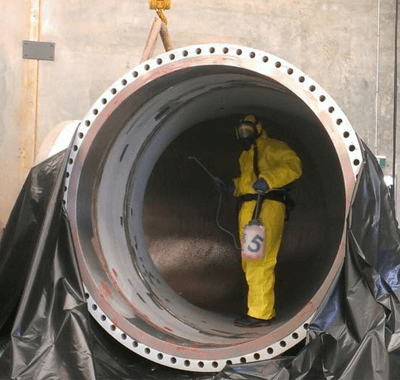Our Onsite Services
In addition to our own facilities, International Corrosion Services also offer direct onsite services for our clients. This service allows us to treat stainless steel pieces, process plants or equipment which may be too large or immobile to transport for treatment.
Our onsite team is highly experienced with specialised onsite expertise, including:
- Identifying the type of treatment required for your project
- Developing a scope of works
- Developing a site-specific treatment operating procedures, in compliance with industry standards
- Developing and implementing health and safety procedures, including risk assessments
- Bunding and waste capture process, for collection and offsite disposal
- Quality control of treatment, incorporating the use of the Forroxyl test a means of ensuring the stainless steel is free from iron contamination
A certificate of completion and conformity will be issued at the conclusion of the project.
Our most regular onsite services are:
- Full pickle and passivation
- Cleaning
- Both treatments to stainless steel
All our standard operating procedures are compliant with the following industry standards:
- ASTM A380, A967
- AS 1627.1, AS 1627.5
Pickle and Passivation
The pickle and passivation of stainless steel should be performed for post weld treatment. This treatment ensures stainless steel is clean from contaminants.
While pickling and passivation gives your stainless steel its best chance of resisting corrosion, it will not remove scratches or abrasion from the surface. Our acceptance criteria is no heat tint on the welds (black burns which can’t be removed, paint pens and markings accepted), no grease, grime or dirt, with a nice clean visual appearance. Stainless steel is at its optimum corrosion resistance when it is kept clean, allowing it to self passivate.
Self passivating is a thin layer of chromium oxide, generating itself due to the metal composition of the stainless steel. This extremely thin layer (commonly called a passive layer) gives stainless steel its corrosion resistant properties. After welding, these self passivating properties are destroyed, leaving stainless steel vulnerable to corrosion if left untreated.
Our pickle and passivation process is in full compliance with:
- ASTM A380
- ASTM A967
- AS1627.1, 1627.5
Offshore Maintenance
Our onsite services and expertise includes offshore maintenance, including oil and gas platforms and other offshore facilities.
Allowing maintenance to lapse on your offshore facilities can lead to corrosion, compromising its structural integrity.
The most common signs of corrosion are pitting and crevice corrosion.
Pitting is a form of corrosion which is often readily visible to the naked eye, and is a symptom of the chromium-rich passive oxide film on tubing breaking down due to exposure in a chloride-rich environment. A higher chloride concentration or increased temperature is more likely to result in the passive film breaking down.
Pitting is not only unsightly, it can eventually cause a situation where tubing could fail. Without the passive film intact to protect the steel, pitting and perforation can occur.
While pitting will initially form in the shape of shallow pits, continued lack of proper maintenance will see the corrosion develop to deep and even connected pits.
Crevice corrosion can be extremely difficult to avoid in tubing. Tight crevices are the biggest risk to steel, with corrosion causing the oxygen concentration in the fluid within to drop.
This lower oxygen concentration increases the likelihood of the passive surface oxide film breaking down, resulting in a shallow pit, which can be disastrous for stainless steel.
Ongoing Maintenance
To extend the design life time of your stainless steel structures, maintenance program procedures and inspection periods are critical.
Inspections prevent excessive corrosion, primarily in offshore and coastal environments, including ensuring water drainage systems are working correctly. If stainless steel is found to be exposed to the elements, particularly coastal or chemicals (such as chlorine), the steel is at risk of corrosion.
Our corrosion maintenance, including cleaning and coating treatments, ensure your stainless steel keeps its structure life, integrity and aesthetic lustre for as long as possible.
To find out more about our Onsite Services or to book a job in, please call our office on (08) 9497 3500 or visit our Contact page here.
 ICS will be closed for the Christmas and New Year period from 12pm, 22 Dec - 9 Jan 2023
ICS will be closed for the Christmas and New Year period from 12pm, 22 Dec - 9 Jan 2023
